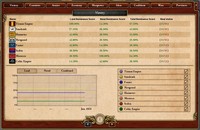Part 65: On the Cusp of War – 1821
March of the EaglesChapter 1 - On the Cusp of War - 1821
The year is 1821, and the world is on the cusp of war.
The flames of the Bavarian Revolution have been all but quashed through the efforts of a powerful French-German-Russian coalition, but the Allied powers have since fallen out over the terms of the Peace of Kraków, allowing the revolutionary Sahim Tirruni to seize power in Catalonia and embark on a series of audacious conquests. Now, the Tirruni Empire sweeps across southern France, Occitania and northern Italy, a great power that has not only undermined monarchism and autocracy, but one that also threatens to destroy the balance of power in Europe.

Through his genius on the battlefield, Tirruni has already dealt crushing defeats to one of the strongest land powers in Europe - France, but his ambitions are not yet sated. Having declared himself Sultan of Sultans and Emperor of Europe, Tirruni intends to carve out a new empire stretching across the continent, with his primary objectives being securing the rest of Italy and expanding into southern France and Bavaria.


The top picture shows Tirruni's objectives, falling under 2 categories: Land and Naval dominance objectives.The bottom is just a quick way to show the military prowess and income for each of the great and regional powers.
With France, Hannover and Smolensk all preparing for wars of their own, it is in north Africa where the strongest opposition to Tirruni presents itself. As the bastion of absolutism in the West, the large and rich Almoravid Empire is determined to undermine the liberal ideals of the Revolution, with Sultan Yahya V focused on deposing Sahim Tirruni and reasserting his hegemony in the Mediterranean.

Possessing the largest and strongest navy of all the great powers, Morocco enters 1821 with unchallenged naval supremacy in the Mediterranean, but its power on the seas is undercut by its relatively small and obsolete land forces. Unless extensive reforms are taken very soon, any land-based battles will undoubtedly end with victory for the enemy.


And indeed, one of the many theatres in the oncoming Tirruni-Almoravid conflict is sure to be the rich but divided Iberian peninsula, where an influence war is already being waged with both words and guns.

The Mahdiyyah, a brutal theocratic regime led by the messiah-esque Mahdi, is little more than a puppet to the Almoravid Sultan Yahya. And with the support of the Berbers, the Mahdi has already carried out a series of conquests into northern Iberia and southern France, only further legitimising his rule.
The rivalry between the Mahdi and the Majlis still runs strong, however, as both powers doggedly plan to unite the entirety of the peninsula and revive al-Andalus. And for that to happen, war between them is inevitable.

Qadis itself is supposedly led by the Majlis al-Shura, an oligarchic parliament of powerful Andalusi nobles, but it is de facto led by Raed al-Zulfiqar, the commander of the army and self-declared Grand Vizier of the Majlis. The nobles seated in the assembly already voted to throw their lot in with Tirruni, sure that his support will be enough to repel the Almoravids and finally defeat the Mahdi.

Half a sea away, meanwhile, the Emirate of Palermo will also likely serve as a battlefield in the coming wars. Small and relatively poor, Palermo is ruled by the autocratic Emir Ibrahim-Yah, scion of the ancient Jizrunid dynasty. Hoping to expand his possessions and see his fortunes rise, the Emir has declared his support for the Almoravid cause, raising the golden Jizrunid banners and preparing for war.

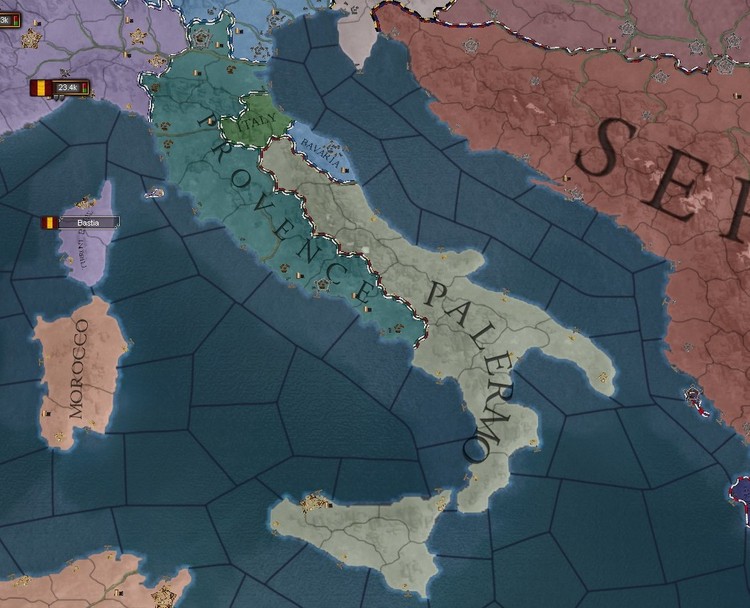
To the north, on the other hand, a separate conflict is brewing between France and the Celtic Empire over the matter of England. Both lay claim to the old kingdom, but with no hope of settling the argument through diplomacy, strength of arms will prove to be the ultimate arbiter.

France is led by the Queen-Mother Aliç de Valois, ruling as regent until her daughter and heir comes of age. In addition to pressing her claims in England, the Queen-Regent has her eye set southward, determined to recapture the territories lost to Tirruni and the Mahdiyyah in recent years. Doing both will prove very difficult to achieve, however, as French manpower reserves are nearly exhausted after almost a decade of destructive war against Bavaria and the Iberian powers.


The Celtic Empire, meanwhile, is ruled by High King Fáelbe ó Kildare. Having suffered a series of humiliating defeats over the past century, the Irish are determined to stymie their decline and seize victory in the approaching wars, bent on reunifying Britain and recapturing their lost possessions in Gharbia.
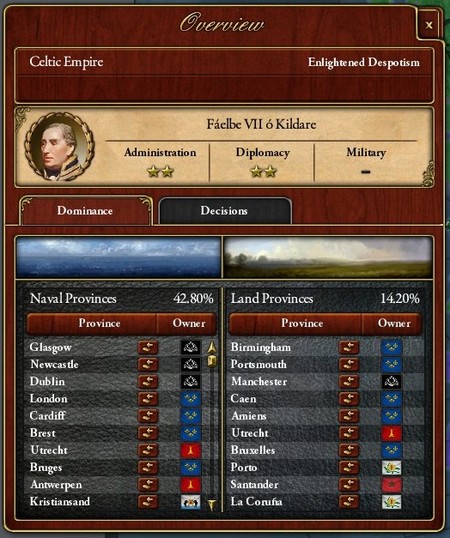

Moving eastward, the borders of Germany have been drastically redrawn by the Peace of Kraków. With Poland and Brandenburg vassalized by Smolensk, and the Rhine Confederacy set up as a puppet under France, the powerful Duke August-Wilhelm of Brunswick felt betrayed by his allies, declaring himself King of Hannover and overlord of North Germany in retaliation.
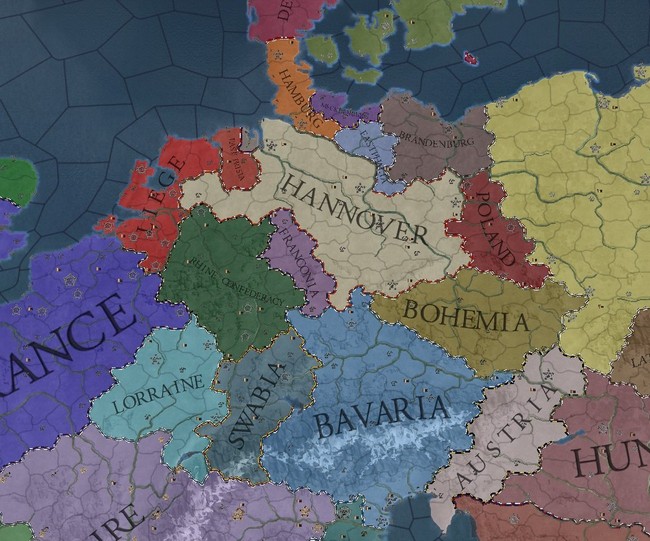
Grand declarations are all well and good, but the truth of them will have to be decided on the battlefield. Anticipating conflict with his former allies and determined to emerge as the dominant German state, King August-Wilhelm has spent the past few months quietly expanding his army, drilling his highly-disciplined troops and drawing up war plans, ready to strike the moment Europe explodes into war.
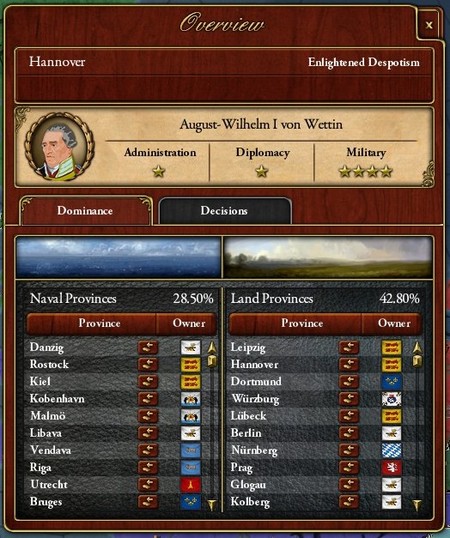
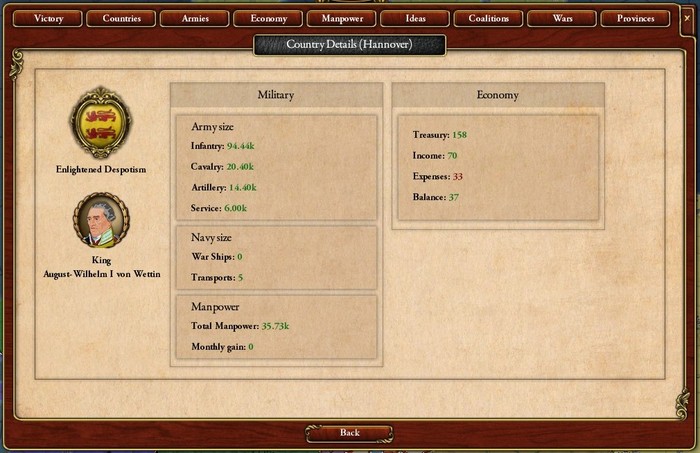
And the biggest obstacle to Hanoverian dominance of Germany stands further south, in the revived Archduchy of Bavaria. Restored to power by the Peace of Kraków, the Godi dynasty rule over a unruly and determinedly liberal population, so their regime is already tenuous and fragile as it is. Despite this, however, the powers in Russia and France seek to use them as a weapon to oppose any expansionism from Hannover, making promises to guarantee and ally with the Archduchy.
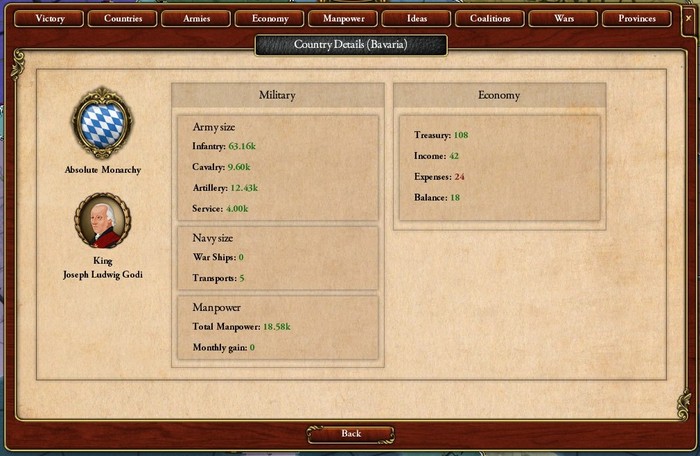
And further east, another massive conflict is on the verge of breaking out, one that has been building up for decades now. Novgorod and Smolensk both arose out of the many squabbling Russian principalities of the Middle Ages, but now that they have both forged continental empires of their own, both also seek to declare themselves as the one and only Empire of All Russia.
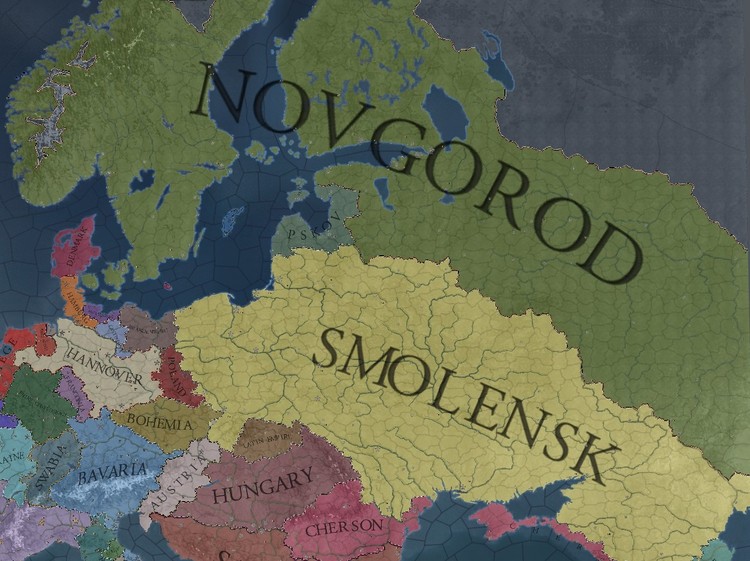
Conflict between the two great powers is all but guaranteed, with the question now being when rather than if. Having successfully crushed the Bavarian Republic a scant few years ago, the proven Tsarina Dobroslava of Smolensk has invested a fortune into expanding her standing army and navy, determined to bring about a quick and decisive end to Novgorod once the time for war arrives. The Tsarina will also have to keep a wary eye westward, however, as Tirruni harbours ambitions of further upsetting the balance of power in Europe.
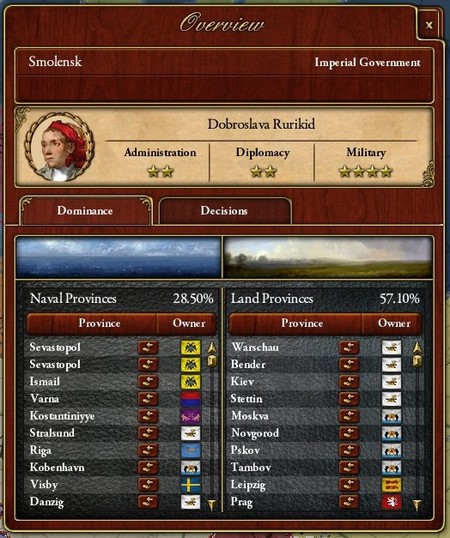

The Tsar of Novgorod and King of Scandinavia has been doing much the same, aggressively raising armies and desperately expanding shipyards, though he has a slightly smaller manpower pool to draw from.
Vasiliy VII also has internal problems to deal with, however, increasingly alienating his Novgorodian subjects as his Scandinavian advisors counsel him to avoid being drawn into the Russian quagmire and focus on Germany instead. There are even rumours that he intends to move the imperial capital closer to Sweden, though this decision will almost certainly be met with rebellion in his Russian territories.
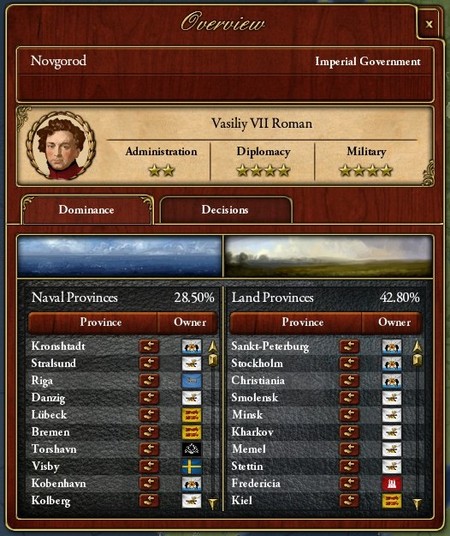
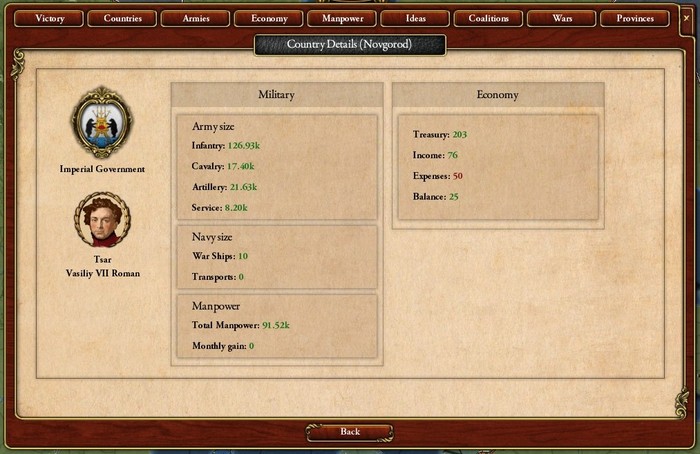
Pushing southwards, we come to the last bastion of true republicanism in Europe - the Serbian Republic. Aggressively expansionistic and politically fragile, the past few popularly-elected Consuls have managed to unite large parts of the Balkan peninsula under their revolutionary regime, though Constantinople and Athens still lay beyond their grasp.
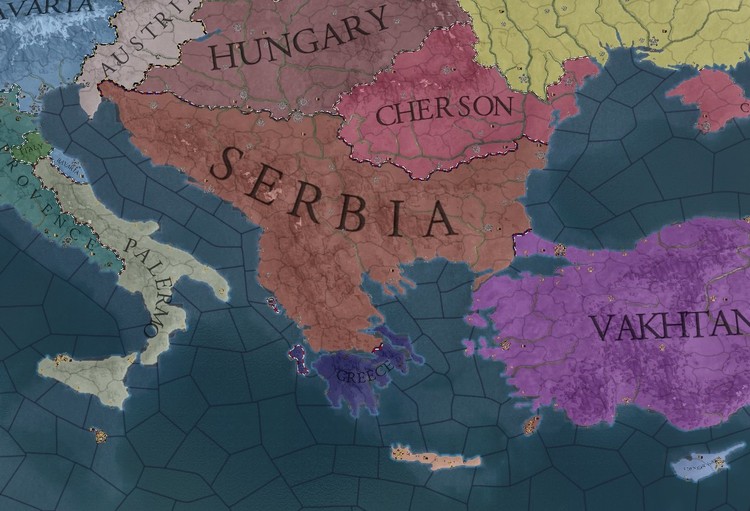
Now led by Consul Konstantin Jovan, the revolutionaries seek to rectify this, also bent on exporting the revolution to Central Europe and Asia Minor.
The republic’s lofty ambitions will have to be balanced carefully, however, as they have already managed to arouse the enmity of a number of powerful states - including Morocco and Egypt. And to further complicate matters, ethnic tensions have been on the rise in recent years, with Serbian authorities forced to deal with a series of uprisings and revolts all across the peninsula.

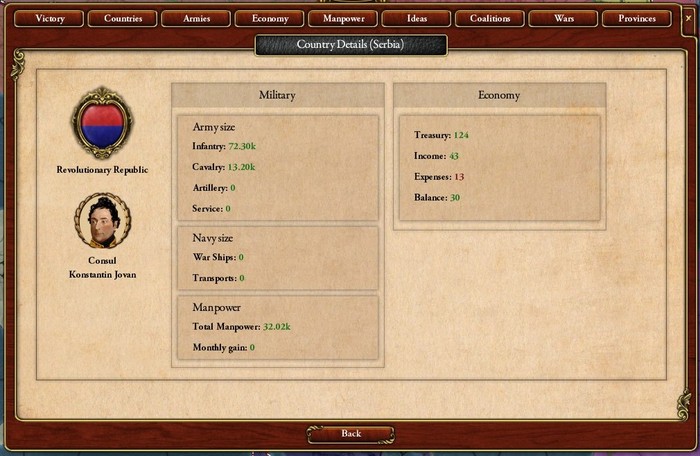
The Near East, meanwhile, is dominated by a three-way struggle between the Vakhtani Caliphate, Crusader Egypt and the Vali Emirate. A Kurdish-Egyptian alliance has seen the fortunes of the Armenians rapidly decline over the past half-century, but the ambitions of the allied powers aren’t yet sated, determined to carve Anatolia between the two of them.

Once the dominant power of the Near East, the Vakhtani Caliphate is now a shadow of its former self, suffering defeat after humiliating defeat to the Christians. Caliph Avedis III was already forced to endure a crushing defeat to the Egyptian-Vali Alliance, but his armies were not completely destroyed during these wars, and he still harbours ambitions to recapture lost territories in Syria and Thrace.
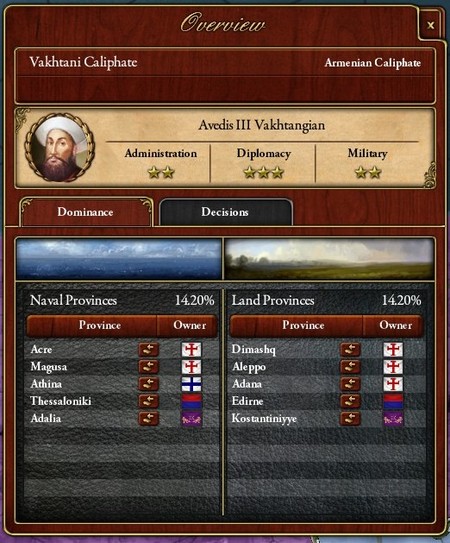
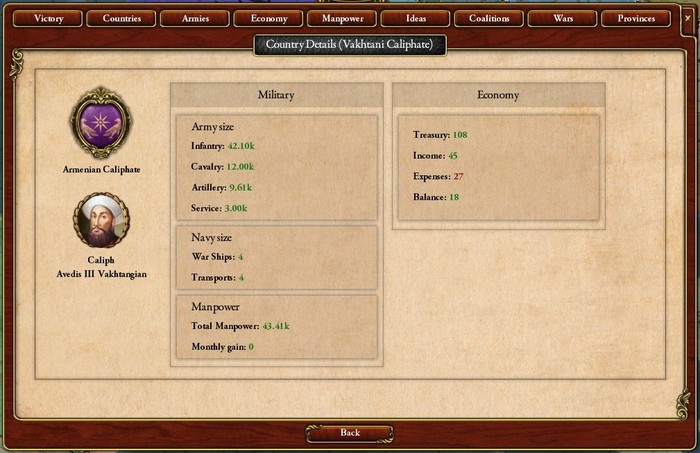
Ruling an empire that stretches from Asia Minor to the Sudan, on the other hand, the successful modernisation reforms undertaken by the Apanoub kings has seen Egypt’s fortunes rapidly rise in recent years. Still not satisfied with his father’s conquests in the Levant, and eager to make a name for himself, King Apanoub XIII plans to wage another war against the Armenian Caliphate. Headstrong and ambitious, he has also declared the Almoravids of Morocco his eternal rival, making a powerful enemy in the Berbers for no apparent reason.
And though his eyes may be set on conquering North Africa and the Middle East, the young king will also have to deal with rising tensions in the Muslim parts of his empire, as a movement to create an Arab republic in Syria quickly gathers steam.
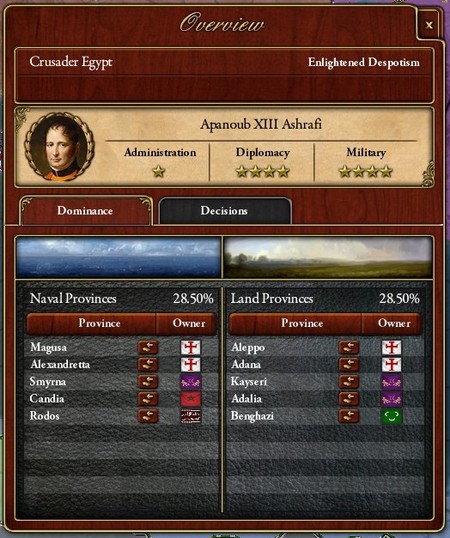
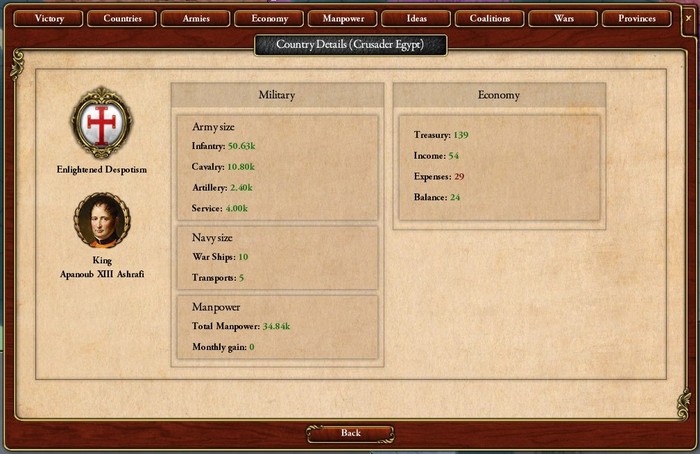
Iberia and north Africa, Britain and France, Germany and Russia, the Balkans and the Near East - all across the old world, armies are being raised and war plans are being drawn up, determined to finally put the conflict between Revolution and Reaction to rest. It was already becoming obvious that the meat of the fighting would happen between the Moroccans and the Tirruni Empire, as the two powers began forming alliance webs against one another.
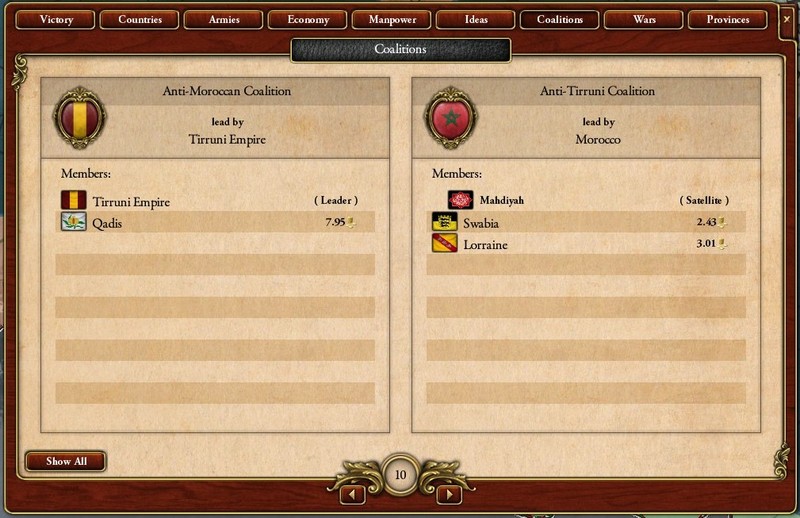
The next fifteen years are sure to be dominated by a frenzied, chaotic struggle between powers great and small, with alliances being desperately wrought and broken, with armies crossing the width of the world to meet on the battlefield, with hundreds of thousands dying under the hot desert sun of the Near East, in the rocky mountainous terrain of Iberia, in the muddy marsh wetlands of western Europe and the icy wastelands of Russia.
The spark that lit the powder-keg came on the morning of the 27th of February, 1821. Berber man o’ wars began firing on Andalusi shipping in the straits of Gibraltar, with a small expeditionary force attempting to land off the coast of Algeciras a few hours later. And with that, the Tirruni Wars begin.
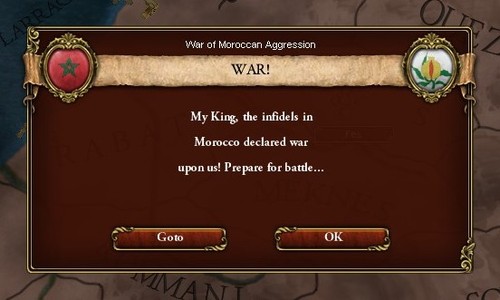
Political map:
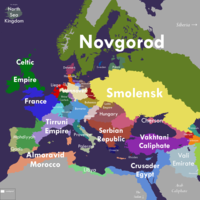
Culture mapmode:
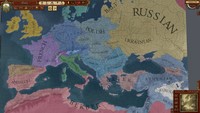
Starting Fort mapmode:

Starting Victory ledger tab:
